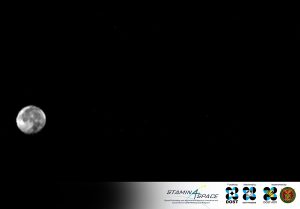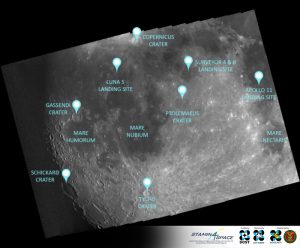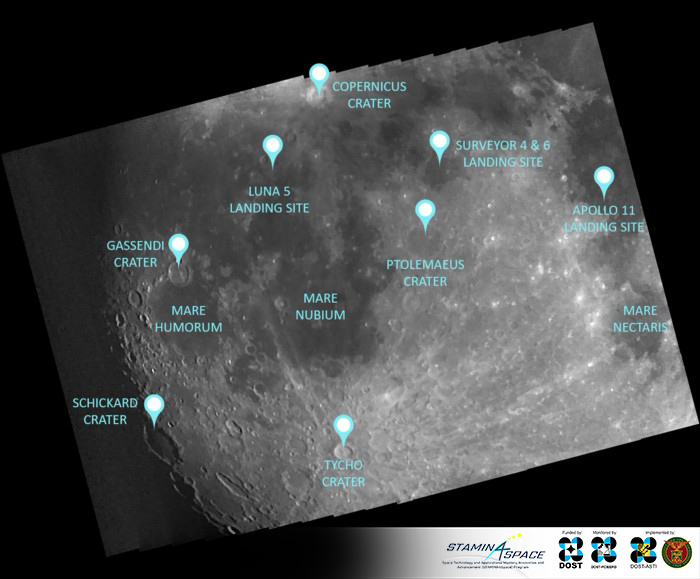Moon serves as useful reference point in target pointing and calibration experiments
As a scientific Earth Observation satellite, Diwata-2’s primary task is to capture images of Earth but it can also be used to target other celestial bodies in our solar system. Recently, Diwata-2 was tasked to take pictures of the Moon as part of an experiment carried out by researchers from the STAMINA4Space Program and Tohoku University in Japan. The experiment was undertaken to test Diwata-2’s target pointing capability, calibrate its sensors, and monitor its health and status. Accurate target pointing is crucial for effectively capturing images of areas identified during mission planning, and the Moon is a good point of reference for target calibration.

Satellite calibration using the Moon
This mission was part of the experiments of Mr. Edgar Paolo Violan, a Department of Science and Technology (DOST) scholar currently pursuing a degree in Master of Science in Aerospace Engineering at the Space Robotics Laboratory of Tohoku University in Japan. Mr. Violan’s research involves using the Attitude Determination and Control System (ADCS) of Diwata-2 to target lunar acquisitions that lead to more precise target pointing maneuvers in capturing observation images. In-flight calibration of the ADCS is implemented as needed to correct any small, but still apparent, misalignments within the satellite’s components.
“From its initial skewed results, the satellite’s attitude sensors settings were adjusted accordingly until the Moon was finally captured and centered in the frame of view of the optical payload used (in this case, the High Precision Telescope or HPT). From the results of the lunar acquisition, we hope to increase the precision of Diwata-2’s Earth observation captures,” says Violan.
The results of the experiments can be used to yield enhancements in the design and implementation of ADCS that can be incorporated in other and future satellites.
“Attitude control systems enable spacecraft and satellites like Diwata-2 to accurately determine and adjust its orientation. As such, its robust performance is crucial to the success of the space mission. These systems also have wide ranging applications outside of space, ranging from autonomous vehicles, navigation to wearable devices for balance control. Therefore, innovation by Filipino engineers and scientists in this technology is important,” says Dr. Joel S. Marciano, Jr., the Director General of the Philippine Space Agency (PhilSA) and formerly Program Leader of the STAMINA4Space Program.
The Ground Receiving, Archiving, Science Product Development and Distribution or GRASPED project, a component of the STAMINA4Space program, assisted in carrying out the experiment. The GRASPED project is in charge of the day to day operations of the Diwata microsatellites, from deciding which targets to acquire to distributing the images to project stakeholders. In this experiment, Violan worked with the GRASPED team in tasking Diwata-2 to perform the acquisition through the Tohoku University Ground Station (CRESST), Sweden’s Kiruna Station, and the Philippine Earth Data Observation (PEDRO) Center at the Advanced Science and Technology Institute of the DOST. The data was then downloaded and processed by GRASPED into the images seen here.

Figure 2. Diwata-2’s first image of the Moon using the 740nm band of its Spaceborne Multispectral Imager (SMI) payload. Image acquired on November 14, 2019.
All eyes on the Moon
While the lunar acquisition experiments served its purpose in improving Diwata-2’s pointing accuracy, it also gave us detailed images of the Moon showing several notable features on its surface. Explorations and studies towards understanding of our planet’s only natural satellite have ensued since the Apollo missions in the ‘60s.
The commercial exploitation of the Moon has now become the subject of heightened international interest with the announcement of the Artemis Accords by NASA, which is in line with the United States-led Artemis Moon program aimed at building long-term human presence on the Moon. According to a recent Reuters news report1, the accords “appear to clear the way for companies to mine the Moon under international law and urge countries to enact similar national laws that would bind their private sector’s space operations.” Included in the plan is the establishment of so-called ‘safety zones’ on the lunar surface that are intended to ensure peaceful coexistence among parties operating Moon bases. Concerns have been raised, however, on how the safety zones might lead to national appropriation and therefore contravene the Outer Space Treaty, which states that the Moon and other celestial bodies are “not subject to national appropriation by claim of sovereignty, by means of use or occupation, or by any other means.”

Figure 3. Notable features include the famous landing sites of Apollo 11, Luna 5, and Surveyor 3 & 4; Tycho Crater, Gassendi Crater, Ptolemaeus Crater, Schickard Crater, Copernicus Crater, Mare Humorum, Mare Nubium, and Mare Nectaris.
References:
¹ Retrieved from: https://www.reuters.com/article/us-space-exploration-artemis/star-trek-not-star-wars-nasa-releases-basic-principles-for-moon-exploration-pact-idUSKBN22R2Z9
Read about Diwata-2 or browse, download, or request for images.

